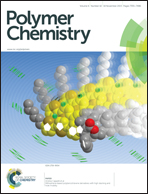Synthesis and self-assembly of amphiphilic bent-shaped molecules based on dibenzo[a,c]phenazine and poly(ethylene oxide) units†
Abstract
Bent-shaped amphiphilic molecules 1–5, consisting of a dibenzo[a,c]phenazine unit and phenyl groups linked together as a rigid segment, and poly(ethylene oxide) (PEO) with a degree of polymerization (DP) of 6, 8 and 12 as flexible chains were synthesized and characterized. Their aggregation behavior was investigated using DSC, POM, SAXS, CD, TEM, and AFM in the bulk and aqueous solutions. Molecules 1–4 with various PEO coil chains self-organize into oblique columnar structures in the solid state. In aqueous solution, molecule 1 (with a DP of 6) self-assembles into spherical aggregates, whereas molecules 2, 3, and 5 (with coil chains longer than those of molecule 1) exhibit a self-organizing capacity to form cylindrical micelles or diverse lengths of fibers, depending on the PEO chain lengths. Interestingly, CD experiments, together with TEM investigations of molecules 4–5 incorporating lateral methyl groups at the interface of the rod and coil domains, showed that these molecules self-assemble into helical fibers. This indicates that lateral methyl groups lead to the formation of helical arrangement of the rod segments.
![Graphical abstract: Synthesis and self-assembly of amphiphilic bent-shaped molecules based on dibenzo[a,c]phenazine and poly(ethylene oxide) units](/en/Image/Get?imageInfo.ImageType=GA&imageInfo.ImageIdentifier.ManuscriptID=C5PY01056J&imageInfo.ImageIdentifier.Year=2015)

 Please wait while we load your content...
Please wait while we load your content...